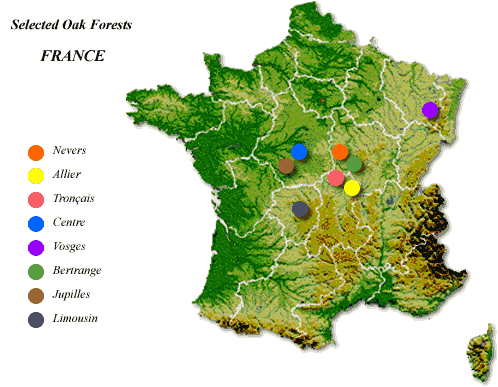The law of unintended consequences can wreak havoc on even the best-laid plans. But sometimes it has delicious upsides.
Case in point: the oak forests of France. If you’ve ever visited a winery – literally, almost any winery – you’ve probably heard about the importance of French oak for making wine. The wood imparts any number of desirable qualities, from pleasing flavors, to beautiful colors to an overall balance in the final product.
But where does all this French oak come from? In alphabetical order, the five main forests from which French oak barrels are made are: Allier, Limousin, Nevers, Tronçais and Vosges, and each is known for certain characteristics. Don’t worry about that right now, though. If you want a mnemonic device to remember them by, I use this one: “A Lady Never Tipples Vulgarly.” Though feel free to make up your own.

A map of France’s major oak forests. Courtesy of Tonnellerie Nadalie.
But I’m not going to dork out on grain tightness, growing conditions and planting standards. Instead…I’m going to dork out on history!
Because some of France’s most famous oak forests were planted not for making wine barrels, but for building ships. France’s favorite megalomaniac, Napoleon himself, ordered some of them planted to supply shipyards for a massive new navy he envisioned. I guess he just couldn’t live down the Battle of Trafalgar.
Tronçais, one of the most famous tracts, actually predates Napoleon’s aspirations to the time of Louis the XIV. His head minister, Jean Baptiste Colbert, ordered the forest replanted after rampant deforestation and land-management corruption in order to supply masts and timber for France’s commercial fleet. Even now, you can still visit a grove of nearly 400-year-old oaks that bears his name.
Fortunately, neither the Sun King nor the Little Emperor lived to see his ambitions fully realized and these plenary plantations have been repurposed to a far nobler purpose (at least to my thinking)…winemaking.
Thus, the drive to build a navy actually resulted in a mainstay of the modern-day wine industry: the oak barrel, without which, wine as we know it would taste completely different.

Oak forests originally planted to build ships are now used to make barrels.
Ironically, like the ships they were originally intended to build, the staves of these oak barrels circumnavigate the globe to wineries and distilleries near and far for the making of spirits, so in a way, they are carrying out their original mission of French commercial domination after all.
As if that weren’t enough of a coincidence, I have a bonus unintended consequence I found in my research that also relates to oak. Over in England, oak was such a precious commodity for the country’s shipbuilding industry that, in 1615, James I issued a royal proclamation forbidding the use of wood for glassmaking. Instead, England’s glassmakers had to begin using coal in their furnaces, which produced stronger glass and eventually led to the wine bottles we use today.
So in a way, we have oak to thank for both the barrel and the bottle.

